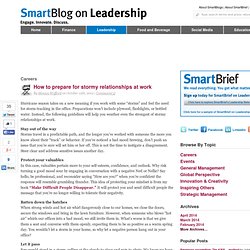

Two Words That Will Immediately Change You As A Leader. Author Andy Stanley states in a leadership podcast there are two powerful words every leader needs to learn, know and use daily.

It doesn’t matter whether you lead a group of 2 or 200, these two words will change your team and the culture of your organization. Stanley says when you express these words, generosity flows. When you fail to use these words, it can send a negative message. The art of leading your peers. How “suffering fools” is a good thing for leaders. Early in my corporate career, when I was a brand assistant at Procter & Gamble, my brand manager sat me down to give some feedback.

A cross-functional team member had approached him and said I didn’t value this person’s opinion during our team meetings. When my brand manager asked me about it, I said, “You’re right. 5 Reasons Your Top Employee Isn't Happy. There has been a bit of a furor recently as both Apple and Microsoft let go key senior executives (Scott Forstall and Steve Sinofsky, respectively) who were both categorized variously as "abrasive," "difficult," and "arrogant.

" In almost every popular account of the firings, the two executives have been painted as "out of control" and having lost the confidence of their peers--to the extent that in each case the CEO (Tim Cook at Apple, Steve Ballmer at Microsoft) had no choice but to reluctantly let them go. "More in sorrow than in anger," as a number of reports put it. There's only one problem with this narrative. Inter.Connect.Ed - Anyone can lead from the negative but it takes a real leader to lead from this positive! Simply take a look at the teams you lead and the teams you are a member off, unless you live in Shangri-La, you’ll quickly see we lead and are led in less than perfect contexts.

As leaders we can choose (yes it is a choice, most just choose not to see the alternative option) to lead from the positive or lead from the negative. Common strategies of leading from the negative: Actively seek out mistakesFocus on the negative impact of mistakeLet others know of the mistake or impactOnly use mistakes to engage in deep dialogueIntentionally allow/setup new team members to make mistakesTell others of a teams weaknessWhen giving feedback only highlight the negativesProvide new opportunities without equal coaching/support.
Find Your Blind Spot: A Self-Reflection Activity for Managers. We humans tend to evaluate others through the lens of our own best traits.

For example, if you perceive yourself as kind, you will likely notice the trait of kindness in others. And you’ll quickly observe where kindness is lacking. I saw this every year when our firm (Hewitt Associates) was selecting new partners. We would ask every current owner to evaluate all the potential candidates for the year. The actuaries expressed enthusiasm for people who were detailed, accurate, timely in response, and thorough. 5 Benefits of Admitting You’re Wrong. “Sweetheart, I don’t think you’re putting it together right.”

My wife hadn’t been in the room for two minutes. I looked up from the headboard I was assembling for our daughter’s new bed and just stared at her. It was late, I’d had a long day, and I simply didn’t have the patience to walk her through how these complicated man-things work, so I pointed to the instruction manual and asked her to look at it herself. It took her about 5 seconds to show me the picture that proved she was right and I was wrong. I felt the emotions flare up inside me. Even as I spoke those words, the emotions were still simmering inside.
Throughout life, we gather a bunch of unwritten rules, subconsciously accepting them as true. 1. 3. 4. 5. Objectively speaking, most of us care more about doing a job right—and doing right by our people—than actually being right. How to prepare for stormy relationships at work. Hurricane season takes on a new meaning if you work with some “storms” and feel the need for storm-tracking in the office.

Preparations won’t include plywood, flashlights, or bottled water. Instead, the following guidelines will help you weather even the strongest of stormy relationships at work. Stay out of the way Storms travel in a predictable path, and the longer you’ve worked with someone the more you know about their “track” or behavior. If you’ve noticed a bad mood brewing, don’t push an issue that you’re sure will set him or her off. This is not the time to instigate a disagreement. Protect your valuables In this case, valuables pertain more to your self-esteem, confidence, and outlook. Batten down the hatches When strong winds and hot air whirl dangerously close to our homes, we close the doors, secure the windows and bring in the lawn furniture.
Let it pass Few would stand in a storm, yelling at the clouds to clear and rain to abate.